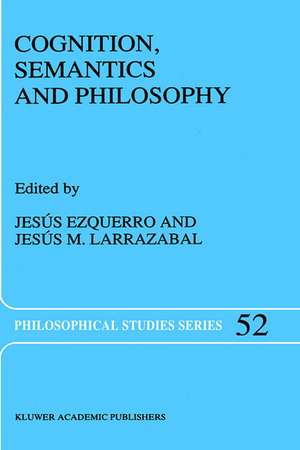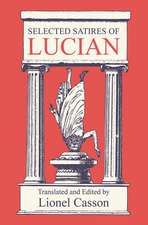Cognition, Semantics and Philosophy: Proceedings of the First International Colloqium on Cognitive Science: Philosophical Studies Series, cartea 52
Editat de J. Ezquerro, Jesús M. Larrazabalen Limba Engleză Hardback – 31 dec 1991
| Toate formatele și edițiile | Preț | Express |
|---|---|---|
| Paperback (1) | 947.18 lei 6-8 săpt. | |
| SPRINGER NETHERLANDS – 21 oct 2012 | 947.18 lei 6-8 săpt. | |
| Hardback (1) | 953.20 lei 6-8 săpt. | |
| SPRINGER NETHERLANDS – 31 dec 1991 | 953.20 lei 6-8 săpt. |
Din seria Philosophical Studies Series
-
 Preț: 407.78 lei
Preț: 407.78 lei - 15%
 Preț: 644.95 lei
Preț: 644.95 lei - 18%
 Preț: 1120.18 lei
Preț: 1120.18 lei - 18%
 Preț: 1005.43 lei
Preț: 1005.43 lei - 15%
 Preț: 640.06 lei
Preț: 640.06 lei -
 Preț: 381.21 lei
Preț: 381.21 lei -
 Preț: 391.61 lei
Preț: 391.61 lei - 15%
 Preț: 640.88 lei
Preț: 640.88 lei - 15%
 Preț: 639.25 lei
Preț: 639.25 lei - 18%
 Preț: 1221.51 lei
Preț: 1221.51 lei - 18%
 Preț: 947.18 lei
Preț: 947.18 lei - 18%
 Preț: 955.56 lei
Preț: 955.56 lei - 18%
 Preț: 950.96 lei
Preț: 950.96 lei - 15%
 Preț: 645.47 lei
Preț: 645.47 lei - 15%
 Preț: 635.79 lei
Preț: 635.79 lei - 15%
 Preț: 644.82 lei
Preț: 644.82 lei - 18%
 Preț: 950.66 lei
Preț: 950.66 lei -
 Preț: 386.00 lei
Preț: 386.00 lei - 15%
 Preț: 644.82 lei
Preț: 644.82 lei - 15%
 Preț: 642.18 lei
Preț: 642.18 lei - 15%
 Preț: 643.48 lei
Preț: 643.48 lei - 18%
 Preț: 944.99 lei
Preț: 944.99 lei - 15%
 Preț: 638.76 lei
Preț: 638.76 lei - 20%
 Preț: 553.25 lei
Preț: 553.25 lei - 20%
 Preț: 560.31 lei
Preț: 560.31 lei - 18%
 Preț: 951.29 lei
Preț: 951.29 lei - 18%
 Preț: 893.40 lei
Preț: 893.40 lei - 20%
 Preț: 566.76 lei
Preț: 566.76 lei - 18%
 Preț: 951.77 lei
Preț: 951.77 lei
Preț: 953.20 lei
Preț vechi: 1162.43 lei
-18% Nou
Puncte Express: 1430
Preț estimativ în valută:
182.40€ • 195.04$ • 152.08£
182.40€ • 195.04$ • 152.08£
Carte tipărită la comandă
Livrare economică 18 aprilie-02 mai
Preluare comenzi: 021 569.72.76
Specificații
ISBN-13: 9780792315384
ISBN-10: 0792315383
Pagini: 324
Ilustrații: XXI, 324 p.
Dimensiuni: 155 x 235 x 21 mm
Greutate: 0.67 kg
Ediția:1992
Editura: SPRINGER NETHERLANDS
Colecția Springer
Seria Philosophical Studies Series
Locul publicării:Dordrecht, Netherlands
ISBN-10: 0792315383
Pagini: 324
Ilustrații: XXI, 324 p.
Dimensiuni: 155 x 235 x 21 mm
Greutate: 0.67 kg
Ediția:1992
Editura: SPRINGER NETHERLANDS
Colecția Springer
Seria Philosophical Studies Series
Locul publicării:Dordrecht, Netherlands
Public țintă
ResearchCuprins
1: Animal Cognition and Human Cognition: A Necessary Dialogue.- I. Introduction.- II. Characterization of Comparative Cognition.- III. Cognitive Modules and Evolution.- IV. Two Goals of Comparative Research: General Processes and Evolutionary Sequences.- V. Consciousness and Cognition.- VI. Conclusions.- 2: User Modelling in Knowledge-Based Systems.- I. Introduction.- II. Situations of Interactive Communications.- III. The Content of the User Model.- IV. Characteristic Dimensions of a User’s Model.- V. Domain-Knowledge: Shallow Versus Deep Modelling.- VI. Modelling Intentions.- VII. Building a User’s Model.- VIII. Learner’s Model.- IX. Conclusion.- 3: Changing Beliefs Rationally: Some Puzzles.- I. Background.- II. A Justification of Generalized Conditionalisation.- III. The Judy Benjamin Problem.- IV. An Apparent Counterexample to Simple Conditionalisation.- V. The Three Prisoners.- VI. Judy Benjamin Again: The Strong Strategy.- VII. Independence.- 4: On the Representation of Linguistic Information.- I. Introduction.- II. The Modularity Hypothesis.- III. Grammar, Pragmatics and Modularity.- IV. Interdisciplinarity in the Analysis of Linguistic Information.- V. Disjunct Adverbials Pragmatically Oriented Towards the Speaker or Hearer.- VI. On The Representation of Disjunct Constituents: A Multidimentional Approach.- VII. Conclusions.- 5: Modelling Memory for Models.- I. Introduction.- II. Two Senses of “Model”.- III. Models in Working Memory.- IV. Representations for Syllogistic Reasoning.- V. Distributed Bindings and Syllogistic Reasoning.- 6: On The Study of Linguistic Performance.- I. A Proposal for “Cognitive Science” and A Specification of it.- II. Current Situation in Linguistic Performance Theory.- III. Some Issues Regarding Research Programs on Linguistic Performance.- IV. Appendix.- 7: Partiality and Coherence in Concept Combination.- I. Introduction.- II. Flexibility and Specificity.- III. Sense Selection.- IV. Sense Generation.- V. Partiality, Coherence andConcept Combination.- VI. Conclusions.- 8: The Labyrinth of Attitude Reports.- I. Mental States.- II. Semantic Contents.- III. Attitude Reports as Explanations.- IV. The Crimmins-Perry Theory.- V. Reports and Reporting.- VI. Two Kinds of Attitude Reports.- VII. Reporting and Explaining.- 9: Aunty’s Own Argument for the Language of Thought.- I. Introduction: Aunty and the Language of Thought.- II. The Threat of Regress.- III. First Stage: Systematic Cognitive Processes.- IV. First Stage: From System to Syntax.- V. Second Stage: The Structure of Thought.- VI. Second Stage: Concepts and Inference.- VII. Two Objections to the Second Stage.- VIII. Conceptualised Thought and the Connectionist Programme.- IX. An Invitation to Eliminativism?.- 10: Cognitive Science And Semantic Representations.- I. Cognitive and Other Sciences as Using Representations.- II. Natural and Rational Representations.- III. Sources of Variability in Representations.- IV. Use of Prescriptive Rules.- V. Description ofNatural Representations.- VI. Token Representations, Long Term Memory Representations, and the Notion of Activation.- VII. Cross-Compatibility with Neurobiology and Artificial Intelligence.- VIII. Conclusion.- 11: Anchoring Conceptual Content: Scenarios And Perception.- I. Scenarios Introduced.- II. Scenarios: Consequences and Comparisons.- III. A Further Level of Content: An Application.- IV. Spatial Reasoning and Action.


























